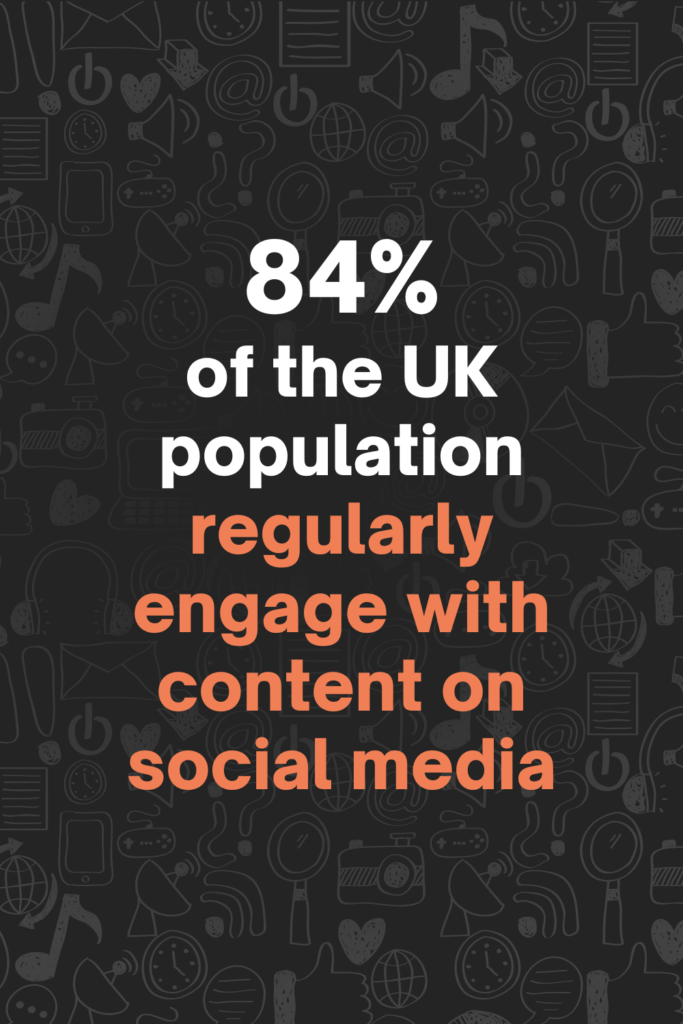If your brand is looking for a diverse and dynamic audience that offers unique opportunities and challenges, then we encourage you to look at the UK audience. Requiring a strategic and creative approach, the UK social media landscape demands a understanding of the intricacies of regional social media. Don’t panic though, we’re here to help you understand the aspects of the UK social media landscape from platform preferences and demographic insights to tips on how to nail localisation content and engagement strategies.
So, let’s dive in and discover how your brand can begin to navigate the UK social media landscape and start achieving remarkable success!
Understanding the UK Audience
Did you know that as of 2023, 84% of the UK population is actively engaged on social media platforms? Turns out we’re a digitally savvy country. The best bit? This high level of engagement provides brands with fertile ground to connect directly with their audiences. Success, however, requires more than just a presence on popular platforms though; it demands a deep understanding of local preferences and behaviours. We’re here to help you discover some of the ways audiences in the UK can differentiate depending on gender, region, behaviours, and preferences.

Demographics and Digital Behaviour
In order to begin understanding the UK Social Media landscape we must first take a look at some of the key demographics of social media users. It is worth noting that these users span various age groups, socioeconomic backgrounds, and interests. With each group engaging with content in their unique way.
- Gen Z (10-25 years): If you’re a brand looking to target Gen Z then you need to be active on TikTok, Instagram, and Snapchat. Ensuring these platforms are part of your strategy is essential as this is where they are most active and engaged. They value authentic and engaging content, often gravitating towards short-form videos and interactive content such as polls and challenges. Brands targeting this demographic should prioritize creativity, humour, and relatability…but don’t try too hard, Gen Z can always tell when a brand is trying too hard.
- Millennials (26-41 years): Millennials, who are now firmly in their professional and family-building years, tend to frequent platforms like Instagram, Facebook, and LinkedIn. However, the amount of millennials engaging on TikTok is growing, so depending on your brand, this may also be a platform to consider. As a collective, they appreciate informative content, brand authenticity, and value-driven marketing. This group is also more likely to engage with long-form content and brand stories that align with their values.
- Gen X and Baby Boomers (42+ years): These older demographics are not to be overlooked, they predominantly stick to the platforms they know including Facebook and LinkedIn. Typically opting to engage more with content that is informative, educational, and relevant to their personal and professional lives. Thought-leadership content often resonates highly with Gen X and Baby Boomers. An effective strategy would also include leveraging Facebook groups and LinkedIn articles to foster community and share expertise.
Regional Variations
If you ask someone from the North and South what they call a bread roll, you will get a multitude of different answers. Well, the same applies on social media, and identifying these regional differences within the UK can further refine and amplify your social media strategy. You may have heard of the great North & South divide, but the cultural and economic landscape actually varies significantly between England, Scotland, Wales, and Northern Ireland, as well as within regions like London, the Midlands, and the North. Let’s have a look at some of these regional differences:
- London: As the economic and cultural hub of the UK, London boasts a typically cosmopolitan audience with diverse interests and a variety of cultural backgrounds. This city is a trendsetter for all things fashion, tech, and finance, making it a fertile ground for innovative brands of all sizes.
- The North: Known for its rich industrial heritage and vibrant cultural scene, Northern England has an enormous sense of community. Utilise content that emphasises local pride, community values, and regional humour when targeting consumers in the North if you really want to leave an impact.
- Scotland: Scottish audiences value authenticity and have a strong cultural identity in their country. Look at engaging with Scottish traditions, key dates, events, and regional dialects to significantly enhance the relatability and impact of your content.
Social Media Behaviours and Preferences
- Engagement Patterns: While every UK user has their own distinct patterns in how they engage with content, there are still trends we can identify on each platform. We know that peak engagement times often differ by platform, with Facebook and Instagram seeing high activity during mornings and evenings, while LinkedIn peaks during weekday business hours. By analysing your own social media platform will allow you to identify the engagement patterns of your audience. Alternatively, tools like Sprout Social also offer the option to schedule content at ‘optimal times’ aka when your audience is most active on the platform.
- Content Preferences: A picture is worth a thousand words. Visual content, particularly videos, tends to perform exceptionally well across all demographics in the UK. When looking to drive higher engagement rates, opt for user-generated content (UGC) and interactive posts such as quizzes, polls, and live videos. In addition to this, UK audiences are responding well to content that reflects current events, societal issues, and popular culture.
- Influencer Impact: Influencers play a pivotal role in shaping consumer opinions in the UK, operating as an online form of word-of-mouth. Having your brand collaborate with influencers who align with your brand values and resonate with your target audience can not only amplify your reach but also increase your credibility. Micro-influencers are often overlooked due to smaller followings, but these influencers typically have highly engaged and loyal followings.
Behavioural Trends
- Sustainability and Ethical Consumption: Over the past few years, UK consumers have become increasingly conscious of sustainability and ethical issues. They are opting for brands that prioritise green initiatives, transparent supply chains, and social responsibility are more likely to earn trust and loyalty.
- Health and Wellness: With mental health services being pushed to the limit in the UK. The focus on well-being is significant, with many UK users seeking content related to mental health, fitness, and holistic wellness. Content focusing on these themes can encourage deeper connections with audiences.
- Digital Savviness: Hard sales aren’t something that sits well with the UK consumers being highly knowledgeable about digital trends can often lead to scepticism of overtly promotional content. Instead opting for brands that provide genuine value, whether through entertainment, education, or exclusive offers.
By utilising these aspects of the UK audience into your social media strategy, global brands can create an effective social media strategy that truly resonates with the audience. At Giraffe, our human-first approach ensures that we don’t just connect brands with their audiences; we foster genuine relationships built on trust, authenticity, and emotional engagement. By leveraging data-driven insights and crafting compelling narratives, we help brands stand out in a crowded digital space and achieve their ambitious goals.
Are you ready to elevate your social media strategy and start making a significant impact in the UK market? Contact Giraffe Social today and let us harness the power of strategy and creativity to drive your brand’s success.






